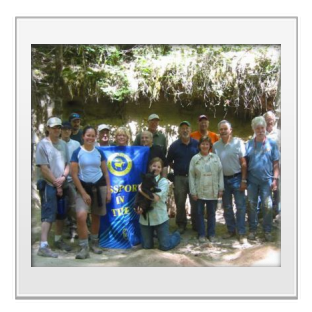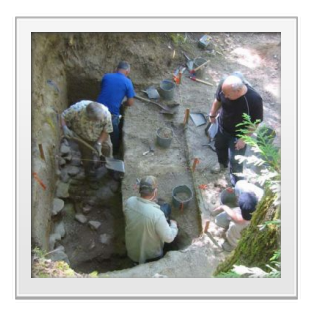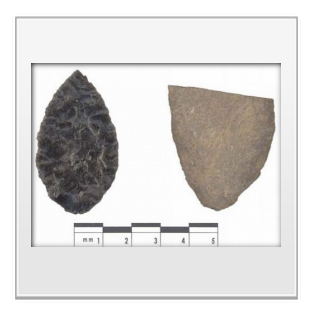Pre-Mazama Research - Passport in Time
Main menu:
PIT Highlights > Headlines > 2010
Pre-Mazama Research
Umpqua National Forest, Oregon, 2009
By Steve Satterthwaite and Larry Wheatley, PIT Volunteers
Screenings - The Oregon Archaeological Society Newsletter Vol. 59 No. 2 February 2010
Screenings - The Oregon Archaeological Society Newsletter Vol. 59 No. 2 February 2010
For a number of years my wife Glenda Satterthwaite and I had talked about applying for a Passport in Time(PIT) project, but never seemed to get around to it. This last year we found an excavation project on the N. Umpqua River, near Roseburg, Oregon that sounded very interesting. After waiting for several weeks, we found out that we had been selected for the second week of the project. Since most of our prior excavation experience had been in Central Oregon, the thought of not working in the blistering heat and having rattlesnakes around every bush really sounded great. An interesting aspect of PIT projects is that volunteers are drawn from all over the US. In our session, there were volunteers from Maryland, N. California and five from around Oregon.
It's a great way to meet people from all over who have the same interests as you. It's also a good way to find potential new OAS members. As it turned out, we met Larry Wheatley from Canyonville, Oregon, and convinced him that the OAS was a great way to get into the amateur Oregon archaeological community. Larry is a relatively new volunteer and was a lot of fun to work with. Much of the information in this article came from copious notes kept by Larry and, for someone like me who relies on memory, his notes were truly invaluable.
Since PIT projects are sponsored by the U.S. Forest Service (USFS), we were provided free camping in any of the USFS campgrounds in the vicinity of the work site along the Umpqua River. We chose Bogus Creek Campground, which is a typical and very nice campground on Oregon Hwy 138. Several others of the volunteers stayed at the campground and some of us carpooled to the excavation site each day.
The site that was being excavated was a suspected Pre-Mazama site which was detected with test probes in preparation for replacing a box culvert with a bridge crossing Williams Creek to facilitate fish passage. Our session started bright and early, Monday July 20, 2009, with introductions among the nine PIT volunteers, as well as Dr. Brian O'Neill, University of Oregon, and Debra Barner, archaeologist with the Umpqua National Forest, who were the co-directors of the project. Since this was the second week of the project all of the 1x1 meter pits had already been opened and partially worked.
As was expected, we did a lot of digging and screening and were not disappointed with the results. Dr. O'Neill's preliminary analysis suggests it may be a habitation site due to the density of debitage, chipped stone tools, cobble tools, fire cracked rock, and charcoal, but additional analysis will be needed. Two of the artifacts found are shown below. They are both bifaces, one of obsidian and the other of basalt, and both came from the paleosol, approximately 60 cm below the ash, in test pit 5.
One thing that did show up rather unexpectedly was a 3 ft rattlesnake which decided to take up residency next to the only toilet for the site. So much for no snakes in W. Oregon! The snake was encouraged to move on, which it did to the great joy of the group since the next facility was several miles away.
The week went fast and I think that everyone felt that they had worn themselves out. There was one more group following ours but their work was cut short after two days because of a large forest fire that burned for many days through the area and closed Hwy 138 for a number of days. Fortunately, the site was spared any damage and a final week's worth of work was completed in mid-November but under much wetter conditions.
The excavation proved to be a fun experience and gave us an insight into PIT opportunities. It was an excellent way to meet and make friends with individuals from outside of the OAS.
Although many of our members have participated in PIT projects in the past, you don't seem to hear as much about it now. This may be due in part to reduced funding by the USFS, a shift in focus away from the program itself by upper management, and the individual preferences of each Forest Supervisor. A big thank you goes to Debra Barner, USFS Archaeologist for the Umpqua area who is one of the PIT programs biggest champions and made this project possible and to Dr. Brian O'Neill for his expertise and ability to keep us all in line.
If you'd like to know more about PIT programs, their website is www.passportintime.com. You'll find listings of current projects available and application forms. Check out the PIT Volunteer Honor Roll and see how many OAS names you recognize!


